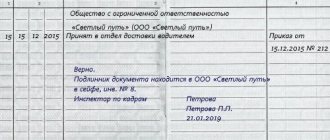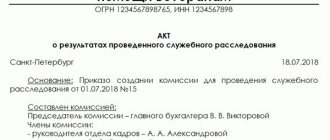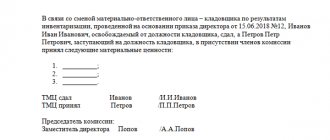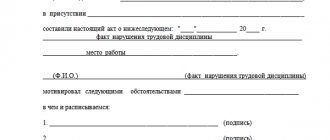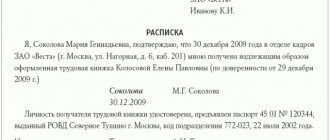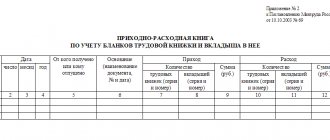Home / Labor Law / Labor book
Back
Published: 06/20/2018
Reading time: 6 min
0
181
A work book is created at the first official employment of a citizen, after which all basic information about his work activity is entered into it. The main function of work books is to reflect the actual length of service, the reasons for dismissal from each place of work, as well as information about education, qualifications and the presence of labor incentives or penalties.
All operations for maintaining and storing these documents are carried out by authorized employees of the personnel services of employing organizations in accordance with legally approved rules. In addition, the legislation also strictly regulates the procedure for transferring valid work books (as well as blank forms) stored in the organization from one authorized person to another.
- Transfer of powers to maintain, store and record work books
- Certificate of acceptance and transfer of work books Registration
- Compilation
One of the main documents required for preparation (and subsequent storage for a legally approved period) when implementing this procedure is the act of acceptance and transfer of work books.
The process of transferring work books
You can’t just take and hand over work books.
- First, it is necessary to issue an order on behalf of the head of the company, which will indicate the need to transfer documents and appoint a new responsible person.
- Then, on the basis of this order, the direct transfer of work books, their inserts and blank forms is carried out, which must be accompanied by their revision, i.e.
inspection, verification, and counting. Information about the transfer is documented in a special act; in addition, this action must be recorded in the journal for recording the movement of work books.
If you follow the entire procedure “from A to Z,” then the risk of encountering the loss of documents, the emergence of disagreements and disputes regarding them will be reduced to a minimum. A competently carried out process also allows the new employee to be relieved of administrative responsibility for the absence of certain work books or inserts.
Transfer of powers to maintain, store and record work books
In the event that the employee responsible for maintaining, storing and recording work books can no longer perform his job duties in the specified part (most often due to reasons of dismissal or transfer to another position), along with his powers, he also transfers to the new responsible person the stored in the organization, employee work books, as well as blank forms.
In accordance with the requirements of the law, the transfer procedure requires documentation, first of all, the drawing up of an appropriate order from the head of the organization, as well as an acceptance certificate:
- The order provides the grounds for appointing a new person responsible for maintaining, storing and recording work books.
- The acceptance and transfer act is drawn up on the basis of the order. In turn, on the basis of the act, the books (including inserts and blank forms) are directly transferred from one authorized person to another.
The transfer procedure must necessarily be accompanied by an audit - checking the condition of the documents themselves, the information entered into them, as well as their calculation and reconciliation with existing data.
If necessary, a special commission consisting of at least two employees of the organization can also be established to carry out the procedure under consideration. Upon completion of the acceptance and transfer procedure, all information about it is recorded in the journal for recording the movement of work books, which is also transferred to the jurisdiction of the new responsible person.
Creation of a commission
If the enterprise is large and there are a lot of documents to be transferred, then to carry out and formalize this procedure it is necessary to create a special commission. It can include employees from different departments of the company, consisting of at least two people. The commission is also appointed by issuing a separate order from the head of the company.
The commission’s task is to check whether all work books are in place, make sure that all the necessary records are present and correspond to reality, and also certify the fact of transfer from one person to another.
Work organization
Since the issue of proper organization of work on the circulation of work books is not directly regulated by current regulations, the employer should take care of this independently. According to many experts, it is advisable to approve local regulations that will regulate this area, and determine, among other things:
- The procedure for organizing personnel work.
- The procedure in accordance with which temporary issuance of work books can be carried out.
- Powers of the employer's officials.
Regulation of temporary issuance
Such local regulations may include:
- Job description of the employee who is appointed responsible for handling books, by order of the manager.
- Instructions on the procedure for temporary issuance of work books to employees of the organization.
- Internal regulations, which include clauses on disciplinary liability.
- Other orders approved by the manager.
Instructions on the procedure for temporary issuance
It is recommended to include in such instructions a clause that obliges an employee who has temporarily received a work book in hand for any purpose to return it no later than the established period. It would not be superfluous to include an indication that the book must be returned in the same condition in which it was received.
Familiarization
After this local act has been properly approved and entered into force, the following employees of the enterprise must be familiarized with its contents:
- A person appointed by order of the manager to be responsible for working with work books}
- Employees who expressed the need to temporarily receive the original document in hand for various purposes. Among the reasons can be named, including provision to the Pension Fund of the Russian Federation, when applying for a pension.
Disciplinary responsibility
To ensure compliance with the norms of the specified instructions, it is advisable to include in such instructions internal regulations and separate norms that will establish disciplinary liability. For example, disciplinary action may be imposed in case of violation of the requirements of local regulations, including acts on the procedure for issuing work books for a short period.
In a similar way, it is also possible to provide for liability for the untimely return or return in poor condition of a book that was temporarily issued to the employee and was damaged due to his fault.
How to compose a document
There is no single, mandatory, unified sample of the act of acceptance and transfer of work books. Companies can choose one of the following methods:
- or write the act in any form each time (which is not very convenient),
- or develop a document template based on your vision and needs, but in this case it must be approved in the accounting policy of the organization.
Regardless of which option the enterprise chooses, the act must include the following data:
- information about the company,
- composition of the commission involved in the transfer of documents,
- information about the work books themselves, inserts in them and new forms - this is best presented in the form of a table.
The form of the acceptance and transfer act may include one sheet or several - if there is a large number of documents. All sheets should be fastened with a strong thread, then on the last outer page next to the fasteners, put a stamp and write the number of sheets, the date of execution of the act and certify this information with the necessary signatures.
When filling out the act of acceptance and transfer of work books, it is important to strive to avoid mistakes and omissions, since entering inaccurate or even false information into it can result in unpleasant consequences for responsible employees. If errors could not be avoided, they should be carefully corrected and certified with the inscription “believe the corrected.” We must not forget that, if necessary, the document can serve as evidence when resolving disagreements through the courts.
Accounting procedure
The work book is a basic document containing the most important information about the employee’s work activity and length of service (under Part 1 of Article 66 of the Labor Code and Clause 2 of the Rules of Government Decree No. 225 of 2003). It contains information about the employee, the work performed, transfers to another position, dismissals, training, awards (under Part 4 of Article 66 of the Labor Code and Clause 4 of Rules No. 225 of 2003).
Upon employment, the employee transfers the work book to his employer under Part 1 of Art. 65 Labor Code. After which the employer is responsible for the safety of the work book.
The employer does not have the right to delegate such responsibilities for ensuring the accounting and storage of work books in favor of another organization or individual. This is indicated by clause 45 of the Rules for maintaining and storing work books No. 225 of 2003.
The person who is responsible for storing and recording work books is appointed by order of the employer or by order of an authorized authority. The person in charge is usually an HR employee. If the previously appointed responsible person has changed, then the work books entrusted to him are transferred on the basis of an acceptance certificate. Most often this happens when the person in charge is fired.
Another option when it is necessary to prepare an act of acceptance and transfer of a work book is the employment of an employee. In this case, he acts as the transferring party, and the employer as the receiving party. But in practice, such an act is usually not drawn up.
How to draw up an act of acceptance and transfer of work books
The act of acceptance and transfer of work books can be written either on a simple A4 sheet or on the organization’s letterhead (the most acceptable option, since in this case the details of the enterprise are immediately entered into it). You can draw up a document either in handwritten form or in printed form - there is no difference here.
It is important to comply with one immutable condition: the act must contain “live” autographs of all members of the commission or persons participating in the transfer and acceptance of work books, as well as the approving signature of the director.
It is not necessary to put a stamp on it, since starting from 2016, legal entities are exempt from the need to endorse their papers with seals and stamps.
An act is drawn up in a single copy , which, after proper execution and final completion of the acceptance and transfer of documents, is transferred for storage to the company’s archive, where it must be kept for the period established by law.
Responsibility of the organization
If the management of the organization has forgotten that issuing a work book upon dismissal is its direct responsibility, then it is obliged to reimburse wages for the entire period of such delay. In this case, even the date of termination of the contract is postponed. The new day of termination of the employment contract is the actual day the documents are issued. To properly document this event, the employer is required to issue a new order and make a new entry. The previous entry in the book about the date of termination of the contract becomes invalid. A similar procedure applies if an erroneous entry is made or an incorrect reason for dismissal.
Legal documents
- Decree of the Government of the Russian Federation dated April 16, 2003 No. 225
- Article 84.1 of the Labor Code of the Russian Federation
Sample of drawing up an act of acceptance and transfer of work books
Filling out the information header of the document
- First, in the middle of the line, write the full name of the company and the title of the document.
- Then the date of drawing up the act and the locality in which the organization is registered are indicated.
- After this, on the right (or on the left - it does not matter) several lines are allocated for approval by the head of the company: here you need to enter his position, last name, first name and patronymic, and also put the date of approval.
- Next, the employee who transmits the work books and the employee who receives them are entered: their positions and personal data are also indicated here.
Filling out the list of work books and inserts
A table that contains all the most basic information about work books:
- last names, first names and patronymics of the owners,
- series and numbers of documents,
- presence of inserts,
- and the necessary notes are also written separately: condition, information about records, demand or lack of demand, etc.
Below the table the total number of documents included in the act is indicated.
The second table reflects information about inserts and blank forms of work books stored at the enterprise. Their series and numbers are also recorded here, but no additional data can be specified.
Finally, the act must be certified by the signatures of the transferring and receiving employee, as well as members of the commission who took part in the procedure for transferring work books. All of them must have their positions indicated, and their signatures must include transcripts.
Sample act of transfer of personnel documents: main contents
| act |
The law does not provide for a unified form of the act of transferring personnel documentation, therefore each enterprise has the right to independently develop this document, guided by its own document flow system and the ease of use of this act. Meanwhile, the practice of personnel records management has developed an act of acceptance and transfer of documentation that is optimal in form and content.
More complete information on the topic can be found in ConsultantPlus. Full and free access to the system for 2 days.
A sample act of transfer of personnel documents is template documentation containing the following information:
- Data of the company where the transfer of personnel papers takes place.
- Date, time and place of the inventory of personnel documents.
- Information about the approval of the act by the management of the organization (date of approval, data of the manager, signature).
- The composition of the commission indicating the surnames, first names, patronymics and positions of its members.
- Information about other persons present during the transfer of cases (as a rule, these are the employees handing over and receiving documents if they are not included in the commission).
- Information about who transmits and who receives documents, as of what date.
- The list of transferred documentation is traditionally written in a table containing the following columns:
- sub-item number;
- names of documents and cases;
- periods or years of document/case management;
- number of documents;
- total number of pages;
- note.
Reasons for compilation
The purpose of this document is to record the movement of a large number of books. If necessary, the employer will be able to use it in the future to confirm this fact. Therefore, drawing up an act of acceptance and transfer of work books according to the model we offer will not be superfluous: everything must be done correctly and without errors.
Such a need may arise in the following situations:
- when changing an employee whose responsibility includes working with books;
- during a company reorganization, if a new structure is separated or an enterprise is acquired;
- when transferring a certain part of the books to individual departments.
There are other possible reasons. The act of acceptance and transfer of work books is necessary in any case, except for issuing the book directly to its owner.
We begin checking documents
Within the period allotted by the order, the commission must check and evaluate:
- completeness and composition of personnel files;
- procedure for registering documents (registration logs);
- a system for storing documents and preparing them for submission to the archive;
- software.
The OK nomenclature of files will be of great help in the work of the commission: after all, all the required folders that should be in the department are listed there. The list may also be specified in the Regulations on OK. If there is no nomenclature in the department, documents and their status will have to be copied en masse - “from cabinet to cabinet.”
It is imperative to check the organization’s personnel documents, namely the presence of:
- copies of the constituent documents and charter of the company;
- staffing table;
- PVTR and collective agreements;
- vacation schedule;
- LNA (provisions on OK, on remuneration, on discipline, on trade secrets, on the protection of personal data);
- shift schedules;
- job descriptions;
- employment contracts;
- agreements on liability;
- orders for core activities;
- orders for personnel (on hiring, dismissal, transfers, discipline);
- personal cards;
- personal affairs;
- work books.
This list is not closed, because your company may lack some documents and present others.
After verification, all documents must be entered into the act.
